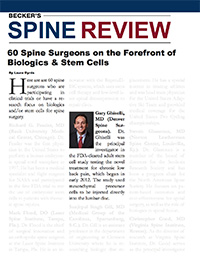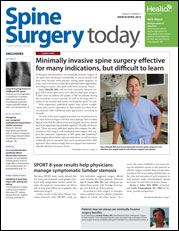Our Physicians
Physician Biography | Dr. Ghiselli's Team | Patient Testimonials | Clinical Studies & Research Papers | Patient Forms
Lumbar Intervertebral Kinematics During an Unstable Sitting Task and Its Association With Standing-Induced Low Back Pain
Dr. Ghiselli recently published a paper based on work he did with the University of Denver assessing lumbar spine intervertebral kinematics of people who do and do not develop standing-induced low back pain. (Kinematics - geometrically possible motion of a body or system of bodies without consideration of the forces involved.)
Allogeneic Mesenchymal Precursor Cells Treatment for Chronic Low Back Pain Associated with Degenerative Disc Disease: A Prospective Randomized, Placebo-Controlled 36-Month Study of Safety and Efficacy
Dr. Ghiselli’s study set out to evaluate the safety and efficacy of a single injection of mesenchymal precursor cells (MPCs, or stem cells) combined with hyaluronic acid. Study subjects had chronic low back pain associated with degenerative disc disease, and were followed for 36 months after their injection.
Results showed that injection of MPCs could be a safe, effective, durable and minimally invasive therapy for subjects who have chronic low back pain.
Becker's Spine Review selects Dr. Gary Ghiselli of Colorado Spine Partners as a spine surgeon leader to know
Gary Ghiselli, MD, a board-certified spine surgeon, is a board member of the Colorado Orthopedic Society. He researches problems in the cervical, thoracic and lumbar spine. Dr. Ghiselli also serves as a Guideline Committee Member for the NASS, is a member of AAOS and the Colorado Medical Society.
Dr. Ghiselli focuses on anti-microbial substrates, stem cell and regenerative technologies in his research. He is a member of the Cervical Spine Research Society and investigates FDA trials dealing with motion preservation in the lumbar spine, cervical total disc replacement and stem cell applications.
He graduated from University of Texas, Southwestern Medical School in Dallas and completed an internship at UCLA General Surgery in Los Angeles. Dr. Ghiselli did his fellowship in spinal surgery with a focus on cervical spine disorders and trauma at the University Hospital of Cleveland under Henry H. Bohlman, MD. Please click here to learn more.

Dr. Gary Ghiselli featured in Becker's Spine Review's "60 Spine Surgeons on the Forefront of Biologics & Stem Cells"
Here are are 60 spine surgeons who are participating in clinical trials or have a research focus on biologics and/or stem cells for spine surgery. Dr. Ghiselli was the principal investigator in the FDA-cleared adult stem cell study testing the novel treatment for chronic low back pain, which began in early 2012. The study used mesenchymal precursor cells to be injected directly into the lumbar disc. Please click here to learn more.
Spine Surgery Today spotlights Dr. Gary Ghiselli on cover page of March / April 2015 publication
Minimally invasive spine surgery effective for many indications, but difficult to learn

Techniques and procedures for minimally invasive surgery of the spine have developed considerably in recent decades and have since become more popular among spine surgeons, in some cases even more so than the traditional open approaches, according to sources who spoke with Spine Surgery Today.
Gary Ghiselli, MD, said he finds minimally invasive surgery (MIS) of the spine more cost-effective than open surgery. It does more to address the quality of life for patients during the immediate recovery period, “as well as the long-term viability of the muscles and tissues overlying the spine,” he said.
Click here to read the complete article.
Dr. Ghiselli was recently involved in a MesoBlast Clinical Study
New York, USA, 29 January and Melbourne, Australia; 30 January 2014: Regenerative medicine company Mesoblast Limited (ASX:MSB; USOTC:MBLTY) today announced positive 12 month outcome results from the 100-patient Phase 2 clinical trial of its proprietary allogeneic, or "off-the-shelf", Mesenchymal Precursor Cells (MPCs) in patients with chronic moderate to severe discogenic low back pain
The results showed that a single injection of MPCs into degenerating intervertebral discs reduced low back pain and improved function for at least 12 months. When compared with controls, MPC-treated patients used less opioids for pain relief, had greater radiographically-determined disc stability, and underwent less additional surgical and non-surgical treatment interventions. MPC treatments also appeared to be well tolerated during the study.
Mesoblast Chief Executive Silviu Itescu said: "We are very pleased that in a trial primarily designed to assess the safety of Mesoblast's cells for intervertebral disc repair, we have seen strong indications of sustained efficacy across a broad number of clinical and radiographic parameters after a single intra-disc injection. On the basis of these positive results, Mesoblast plans to meet shortly with regulatory authorities in major jurisdictions, including the United States Food and Drug Administration, to discuss product registration trials for the potential treatment of disc degeneration."
Dr Gary Ghiselli, Clinical investigator and local, fellowship-trained spine surgeon at Colorado Spine Partners said: “We are very excited by these results. This is compelling evidence that stem cell technology has the potential to change the treatment of spinal disease. Physicians and patients are seeking access to a new modality to treat patients with this highly debilitating disease for whom there are limited options. We hope that these outcomes will be replicated in a pivotal trial."
The results of the Phase 2 clinical trial build on and extend previously reported preclinical studies which showed that Mesoblast’s highly purified and immunoselected MPCs were able to increase proteoglycan content and improve disc structure in an experimental ovine model of disc degeneration.
Mesoblast's Phase 2 clinical trial enrolled 100 patients with moderate to severe low back pain persisting for more than 6 months and caused by early disc degeneration. Patients underwent the outpatient injection for a single painful degenerated lumbar level and are being evaluated for safety and efficacy over a total of 36 months to evaluate long-term treatment effects.
Click here to read the complete release.
Click here to download a Mesoblast Stem Cell Production Visual.
Dr. Ghiselli involved in a study on anterior cervical fusion
Gary Ghiselli, MD, Sanjay Jatana, MD, David Wong, MD, MSc, FRCS (C), Nicholas Wharton, MD. Pseudarthrosis in the Cervical Spine: What Is the Gold Standard? CT Scan versus Flexion Extension Quantitative Motion Analysis With Intraoperative Correlation. Proceedings of the NASS 21st Annual Meeting / The Spine Journal 6 (2006) 1S–161S.
Purpose: Attempt to establish a gold standard for determining pseudoarthrosis in anterior cervical fusion. Read more.

